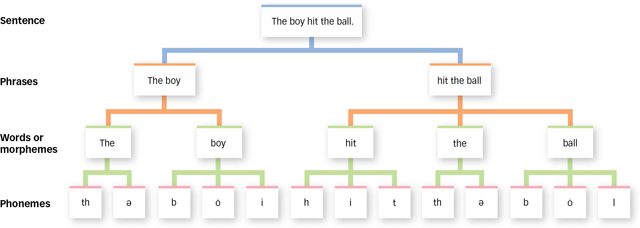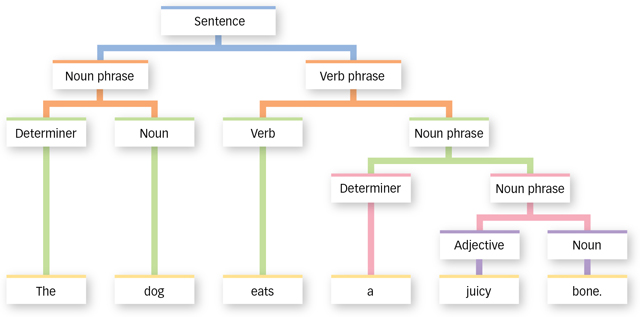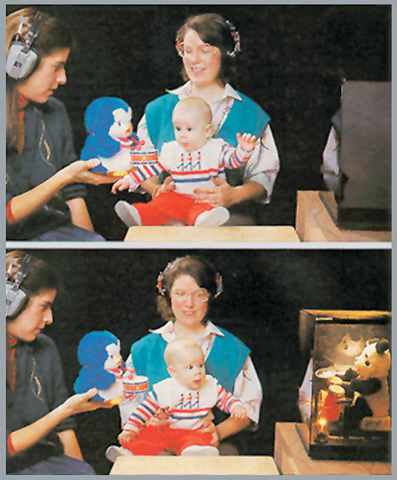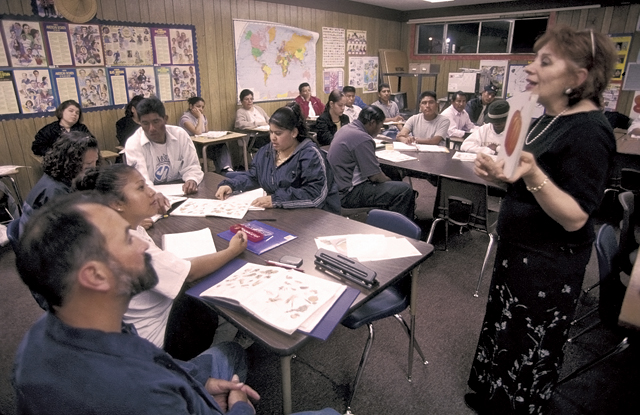9.1 Language and Communication: From Rules to Meaning

Most social species have systems of communication that allow them to transmit messages to each other. Honeybees communicate the location of food sources by means of a “waggle dance” that indicates both the direction and distance of the food source from the hive (Kirchner & Towne, 1994; Von Frisch, 1974). Vervet monkeys have three different warning calls that uniquely signal the presence of their main predators: a leopard, an eagle, and a snake (Cheney & Seyfarth, 1990). A leopard call provokes them to climb higher into a tree; an eagle call makes them look up into the sky. Each different warning call conveys a particular meaning and functions like a word in a simple language.

Language is a system for communicating with others using signals that are combined according to rules of grammar and convey meaning. Grammar is a set of rules that specify how the units of language can be combined to produce meaningful messages. Language allows individuals to exchange information about the world, coordinate group action, and form strong social bonds.
What are the distinctions between human language and animal communication?
Human language may have evolved from signalling systems used by other species. However, three striking differences distinguish human language from vervet monkey yelps, for example. First, the complex structure of human language distinguishes it from simpler signalling systems. Most humans can express a wide range of ideas and concepts as well as generate an essentially infinite number of novel sentences. Second, humans use words to refer to intangible things, such as unicorn or democracy. These words could not have originated as simple alarm calls. Third, we use language to name, categorize, and describe things to ourselves when we think, which influences how knowledge is organized in our brains. It is doubtful that honeybees consciously think, “I will fly north today to find more honey so the queen will be impressed!”
In this section, we will examine the elements of human language that contribute to its complex structure, the ease with which we acquire language despite this complexity, and how both biological and environmental influences shape language acquisition and use. We will also look at startling disorders that reveal how language is organized in the brain and at researchers’ attempts to teach apes human language. Finally, we will consider the long-
9.1.1 The Complex Structure of Human Language
What do all languages have in common?
Compared with other forms of communication, human language is a relatively recent evolutionary phenomenon, emerging as a spoken system no more than 1 to 3 million years ago and as a written system as little as 6000 years ago. There are approximately 4000 human languages, which linguists have grouped into about 50 language families (Nadasdy, 1995). Despite their differences, all of these languages share a basic structure involving a set of sounds and rules for combining those sounds to produce meanings.
9.1.1.1 Basic Characteristics
The smallest units of sound that are recognizable as speech rather than as random noise are phonemes. These building blocks of spoken language differ in how they are produced. For example, when you say ba, your vocal cords start to vibrate as soon as you begin the sound, but when you say pa, there is a 60-
Every language has phonological rules that indicate how phonemes can be combined to produce speech sounds. For example, the initial sound ts is acceptable in German but not in English. Typically, people learn these phonological rules without instruction, and if the rules are violated, the resulting speech sounds so odd that we describe it as speaking with an accent.
Phonemes are combined to make morphemes, the smallest meaningful units of language (see FIGURE 9.1). For example, your brain recognizes the p sound you make at the beginning of pat as a speech sound, but it carries no particular meaning. The morpheme pat, on the other hand, is recognized as an element of speech that carries meaning.

 Figure 9.1: Units of Language A sentence —the largest unit of language—
Figure 9.1: Units of Language A sentence —the largest unit of language—All languages have grammar rules that generally fall into two categories: rules of morphology and rules of syntax. Morphological rules indicate how morphemes can be combined to form words. Two classes of morphemes—
Content and function morphemes can be combined and recombined to form an infinite number of new sentences, which are governed by syntax. Syntactical rules indicate how words can be combined to form phrases and sentences. A simple syntactical rule in English is that every sentence must contain one or more nouns, which may be combined with adjectives or articles to create noun phrases (see FIGURE 9.2). A sentence also must contain one or more verbs, which may be combined with adverbs or articles to create verb phrases. So, the utterance “dogs bark” is a full sentence, but “the big grey dog over by the building” is not.

 Figure 9.2: Syntactical Rules Syntactical rules indicate how words can be combined to form sentences. Every sentence must contain one or more nouns, which may be combined with adjectives or articles to create a noun phrase. A sentence also must contain one or more verbs, which may be combined with noun phrases, adverbs, or articles to create a verb phrase.
Figure 9.2: Syntactical Rules Syntactical rules indicate how words can be combined to form sentences. Every sentence must contain one or more nouns, which may be combined with adjectives or articles to create a noun phrase. A sentence also must contain one or more verbs, which may be combined with noun phrases, adverbs, or articles to create a verb phrase.
9.1.1.2 Meaning: Deep Structure versus Surface Structure
Sounds and rules are critical ingredients of human language that allow us to convey meaning. A sentence can be constructed in a way that obeys syntactical and other rules, yet be entirely lacking in meaning or semantics, as in the famous example provided by linguist Noam Chomsky (1957, p. 15), “Colourless green ideas sleep furiously.” Though we would not be breaking any grammatical rules by uttering such a sentence, we could expect to elicit head scratches and strange looks from any nearby listeners. Language usually conveys meaning quite well, but everyday experience shows us that misunderstandings can occur. These errors sometimes result from differences between the deep structure of sentences and their surface structure (Chomsky, 1957). Deep structure refers to the meaning of a sentence. Surface structure refers to how a sentence is worded. “The dog chased the cat” and “The cat was chased by the dog” mean the same thing (they have the same deep structure) even though on the surface their structures are different.

Is the meaning or wording of a sentence typically more memorable?
To generate a sentence, you begin with a deep structure (the meaning of the sentence) and create a surface structure (the particular words) to convey that meaning. When you comprehend a sentence, you do the reverse, processing the surface structure in order to extract the deep structure. After the deep structure is extracted, the surface structure is usually forgotten (Jarvella, 1970, 1971). In one study, researchers played tape-
9.1.2 Language Development
Language is a complex cognitive skill, yet we can carry on complex conversations with playmates and family before we begin school. Three characteristics of language development are worth bearing in mind. First, children learn language at an astonishingly rapid rate. The average 1-
9.1.2.1 Distinguishing Speech Sounds

What language ability do infants have that adults do not?
At birth, infants can distinguish among all of the contrasting sounds that occur in all human languages. Within the first 6 months of life, they lose this ability, and, like their parents, can only distinguish among the contrasting sounds in the language they hear being spoken around them. For example, two distinct sounds in English are the l sound and the r sound, as in lead and read. These sounds are not distinguished in Japanese; instead, the l and r sounds fall within the same phoneme. Japanese adults cannot hear the difference between these two sounds, but American adults can distinguish between them easily—
In one study of 1 to 4-

Infants can distinguish among speech sounds, but they cannot produce them reliably, relying mostly on cooing (i.e., simple vowel-
In order for vocal babbling to continue, however, infants must be able to hear themselves. In fact, delayed babbling or the cessation of babbling merits testing for possible hearing difficulties. Babbling problems can lead to speech impairments, but they do not necessarily prevent language acquisition. Deaf infants whose parents communicate using American Sign Language (ASL) begin to babble with their hands at the same age that hearing children begin to babble vocally—
9.1.2.2 Language Milestones
At about 10 to 12 months of age, infants begin to utter (or sign) their first words. By 18 months, they can say about 50 words and can understand several times more than that. Toddlers generally learn nouns before verbs, and the nouns they learn first are names for everyday, concrete objects (e.g., chair, table, milk) (see TABLE 9.1 below). At about this time, their vocabularies undergo explosive growth. By the time the average child begins school, a vocabulary of 10 000 words is not unusual. By fifth grade, the average child knows the meanings of 40 000 words. By university, the average student’s vocabulary is about 200 000 words. Fast mapping, in which children map a word onto an underlying concept after only a single exposure, enables them to learn at this rapid pace (Kan & Kohnert, 2008; Mervis & Bertrand, 1994). This astonishingly easy process contrasts dramatically with the effort required later to learn other concepts and skills, such as arithmetic or writing.
|
Average Age |
Language Milestones |
|---|---|
|
0– |
Can tell the difference between speech sounds (phonemes) that are not distinguished in their native language. Cooing, especially in response to speech. |
|
4– |
Babbles consonants. |
|
6– |
Understands some words and simple requests. Can no longer reliably distinguish sounds that are not in their native language. |
|
10– |
Begins to use single words. |
|
12– |
Vocabulary of 30 to 50 words (simple nouns, adjectives, and verbs). |
|
18– |
Two- |
|
24– |
Vocabulary of about 1000 words. Production of phrases and incomplete sentences. |
|
36– |
Vocabulary grows to more than 10 000 words; production of full sentences; mastery of grammatical morphemes (such as -ed for past tense) and function words (such as the, and, but). Can form questions and negations. |
In what way do 2-
Around 24 months, children begin to form two-
9.1.2.3 The Emergence of Grammatical Rules
Evidence of the ease with which children acquire grammatical rules comes from some interesting errors that children make while forming sentences. If you listen to average 2-
Why is it unlikely that children are using imitation to pick up language?
These errors show that language acquisition is not simply a matter of imitating adult speech. Instead, children acquire grammatical rules by listening to the speech around them and using the rules to create verbal forms they have never heard. They manage this without explicit awareness of the grammatical rules they have learned. In fact, few children or adults can articulate these rules of their native language, yet the speech they produce obeys these rules.
By about 3 years of age, children begin to generate complete simple sentences that include function words (e.g., “Give me the ball” and “That belongs to me”). The sentences increase in complexity over the next 2 years. By 4 to 5 years of age, many aspects of the language acquisition process are complete. As children continue to mature, their language skills become more refined, with added appreciation of subtler communicative uses of language, such as humour, sarcasm, or irony.
9.1.2.4 Language Development and Cognitive Development
Language development typically unfolds as a sequence of steps in which one milestone is achieved before moving on to the next. Nearly all infants begin with one-
Why are studies of internationally adopted children especially useful?
These two possibilities are difficult to tease apart, but recent research has begun to do so using a novel strategy: examining the acquisition of English by internationally adopted children who did not know any English prior to adoption (Snedeker, Geren, & Shafto, 2007, 2012). According to government statistics, there were just over 8600 international adoptions to the United States in 2012 (U.S. Department of State, 2013). Although most of those adoptees are infants or toddlers, a significant proportion is composed of preschoolers. Studying the acquisition of English in such an older population provides a unique opportunity to explore the relationship between language development and cognitive development. If the orderly sequence of milestones that characterizes the acquisition of English by infants is a by-

Snedeker and her colleagues (2007) examined preschoolers ranging from 2½ to 5½ years old, 3 to 18 months after they were adopted from China. They did so by mailing materials to parents, who periodically recorded language samples in their homes and also completed questionnaires concerning specific features of language observed in their children. These data were compared to similar data obtained from monolingual infants. The main result was clear-
These results indicate that some of the key milestones of language development depend on experience with English. However, the adopted children did add new words to their vocabularies more quickly than infants did, perhaps reflecting an influence of general cognitive development. Overall, though, the main message from this study is that observed shifts in early language development reflect specific characteristics of language learning rather than general limitations of cognitive development. A later study provided additional support for this general conclusion, but also produced new evidence for a role of cognitive development in specific aspects of language (Snedeker et al., 2012). For example, adopted preschoolers acquire words that refer to the past or the future, such as tomorrow, yesterday, before, or after, much more quickly than do infants, perhaps reflecting that infants have difficulty representing these abstract concepts and therefore take longer to learn the words than more cognitively sophisticated preschoolers.
9.1.3 Theories of Language Development
We know a good deal about how language develops, but what underlies the process? The language acquisition process has been the subject of considerable controversy and (at times) angry exchanges among scientists coming from three different approaches: behaviourist, nativist, and interactionist.
9.1.3.1 Behaviourist Explanations
To a behaviourist, why will an infant repeat “da-
According to B. F. Skinner’s behaviourist explanation of language learning, we learn to talk in the same way we learn any other skill: through reinforcement, shaping, extinction, and the other basic principles of operant conditioning that you learned about in the Learning chapter (Skinner, 1957). As infants mature, they begin to vocalize. Those vocalizations that are not reinforced gradually diminish, and those that are reinforced remain in the developing child’s repertoire. So, for example, when an infant gurgles “prah,” most parents are pretty indifferent. However, a sound that even remotely resembles “da-
The behavioural explanation is attractive because it offers a simple account of language development, but the theory cannot account for many fundamental characteristics of language development (Chomsky, 1986; Pinker, 1994; Pinker & Bloom, 1990).
First, parents do not spend much time teaching their children to speak grammatically. In one well-
documented study, researchers found that parents typically respond more to the truth content of their children’s statements than to the grammar (Brown & Hanlon, 1970). So, for example, when a child expresses a sentiment such as “Nobody like me,” his or her mother will respond with something like “Why do you think that?” or “I like you!” rather than “Now, listen carefully and repeat after me: Nobody likes me.” Second, children generate many more grammatical sentences than they ever hear. This shows that children do not just imitate; they learn the rules for generating sentences. You will recall that the same deep structure can generate a multitude of surface structures. It is highly unlikely that each of those separate surface structures was heard, reinforced, and learned by the developing child; it is much more likely that children simply acquire the ability to generate grammatical sentences.
Third, as you read earlier in this chapter, the errors children make when learning to speak tend to be overgeneralizations of grammatical rules. The behaviourist explanation would not predict these overgeneralizations if children were learning through trial and error or simply imitating what they hear. That is, it would be difficult to overgeneralize if language development consisted solely of reinforced individual sentences or phrases.
9.1.3.2 Nativist Explanations
The study of language and cognition underwent an enormous change in the 1950s, when linguist Noam Chomsky (1957, 1959) published a blistering reply to the behaviourist approach. According to Chomsky, language-

Christopher’s story is consistent with the nativist view of language development: His genius for language acquisition, despite his low overall intelligence, indicates that language capacity can be distinct from other mental capacities. Other individuals show the opposite pattern: People with normal or nearly normal intelligence can find certain aspects of human language difficult or impossible to learn. This condition is known as genetic dysphasia, a syndrome characterized by an inability to learn the grammatical structure of language despite having otherwise normal intelligence. Genetic dysphasia tends to run in families, and a single dominant gene has been implicated in its transmission (Gontier, 2008; Gopnik, 1990a, 1990b; Vargha-
She remembered when she hurts herself the other day.
Carol is cry in the church.
Notice that the ideas these children are trying to communicate are intelligent. Their problems with grammatical rules persist even if they receive special language training. When asked to describe what she did over the weekend, one child wrote, “On Saturday I watch TV.” Her teacher corrected the sentence to “On Saturday, I watched TV,” drawing attention to the -ed rule for describing past events. The following week, the child was asked to write another account of what she did over the weekend. She wrote, “On Saturday I wash myself and I watched TV and I went to bed.” Notice that although she had memorized the past-
How would a nativist explain why deaf infants babble?
As predicted by the nativist view, studies of people with genetic dysphasia suggest that normal children learn the grammatical rules of human language with ease in part because they are “wired” to do so. This biological predisposition to acquire language explains why newborn infants can make contrasts among phonemes that occur in all human languages—

Also consistent with the nativist view is evidence that language can be acquired only during a restricted period of development, as has been observed with songbirds. If young songbirds are prevented from hearing adult birds sing during a particular period in their early lives, they do not learn to sing. A similar mechanism seems to affect human language learning, as illustrated by the tragic case of Genie (Curtiss, 1977). At the age of 20 months, Genie was tied to a chair by her parents and kept in virtual isolation. Her father forbade Genie’s mother and brother to speak to her, and he himself only growled and barked at her. She remained in this brutal state until the age of 13. Genie’s life improved substantially and she received years of language instruction, but it was too late. Her language skills remained extremely primitive. She developed a basic vocabulary and could communicate her ideas, but she could not grasp the grammatical rules of English.
Similar cases have been reported, with a common theme: Once puberty is reached, acquiring language becomes extremely difficult (Brown, 1958). Data from studies of language acquisition in immigrants support this conclusion. In one American study, researchers found that the proficiency with which immigrants spoke English depended not on how long they would lived in the United States, but on their age at immigration (Johnson & Newport, 1989). Those who arrived as children were the most proficient, whereas those who immigrated after puberty, showed a significant decline in proficiency regardless of the number of years in their new country. More recent work using fMRI shows that acquiring a second language early in childhood (between 1 and 5 years of age) results in very different representation of that language in the brain than does acquiring that language much later (after 9 years of age) (Bloch et al., 2009).
9.1.3.3 Interactionist Explanations
How does the interactionist theory of language acquisition differ from behaviourist and nativist theories?
Nativist theories are often criticized because they do not explain how language develops; they merely explain why. A complete theory of language acquisition requires an explanation of the processes by which the innate, biological capacity for language combines with environmental experience. The interactionist approach is that although infants are born with an innate ability to acquire language, social interactions play a crucial role in language. Interactionists point out that parents tailor their verbal interactions with children in ways that simplify the language acquisition process: They speak slowly, enunciate clearly, and use simpler sentences than they do when speaking with adults (Bruner, 1983; Farrar, 1990).

Further evidence of the interaction of biology and experience comes from a fascinating study of deaf children’s creation of a new language (Senghas, Kita, & Ozyurek, 2004). Prior to about 1980, deaf children in Nicaragua stayed at home and usually had little contact with other deaf individuals. In 1981, some deaf children began to attend a new vocational school. At first, the school did not teach a formal sign language, and none of the children had learned to sign at home, but the children gradually began to communicate using hand signals that they invented.
Over the past 30 years, their sign language has developed considerably (Pyers et al., 2010), and researchers have studied this new language for the telltale characteristics of languages that have evolved over much longer periods. For instance, mature languages typically break down experience into separate components. When we describe something in motion, such as a rock rolling down a hill, our language separates the type of movement (rolling) and the direction of movement (down). If we simply made a gesture, however, we would use a single continuous downward movement to indicate this motion. This is exactly what the first children to develop the Nicaraguan sign language did. But younger groups of children, who have developed the sign language further, use separate signs to describe the direction and the type of movement—
Human language is characterized by a complex organization—
from phonemes to morphemes to phrases and finally to sentences. Each of these levels of human language is constructed and understood according to grammatical rules that are acquired early in development, even without being taught explicitly. Instead, children appear to be biologically predisposed to process language in ways that allow them to extract these grammatical rules from the language they hear.